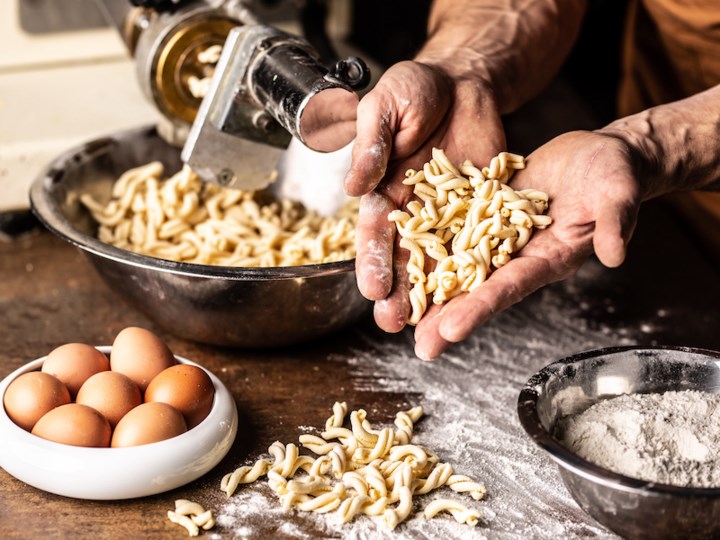Macaroni, pasutice, ravioli, gnocchi, fuzi - these are just some of the
types of pasta made in beautiful Istria. The hard life of the old Istrians was the biggest influence on marking the gastronomy and dishes that have been prepared on this peninsula since ancient times. On the way from the Italian provinces all the way to Istria, various names and forms of pasta slowly changed and then turned into
authentic Istrian culinary specialties. From grains of salt, white flour, sometimes homemade eggs, a little water and
with a lot of love, homemade Istrian pasta was made then as well as today. In the following text, we will briefly describe the recipes of each Istrian type of pasta and we believe that this will be a new challenge for you to
try making yourself. There is nothing better than homemade pasta made with love, which can be enjoyed by the whole family, and we believe that your youngest members will also
enjoy mixing dough and making various shapes :)
Istrian Fuzi
For this pasta you need flour, salt, eggs and water. Knead a smooth dough that is thinly rolled out and then
cut into diamonds 3 to 4cm wide. When the dough has become compact, use a stick to wrap one end of the rhombus around the other and press it to stick. Once you have formed the fuzi, cook them in salted water. They are an ideal side dish for
various stews as well as with
truffle or asparagus sauce.
Potato gnocchi
In Istria gnocchi are made from
quality potatoes that need to be cooked in their peel. After they are cooked, they need to be peeled and pressed. It is then mixed with flour and a little salt and kneaded into a dough from which gnocchi are then formed. They are cooked in boiling salted water. It is an ideal addition to
traditional stews.
 Istrian pasutice
Istrian pasutice
Place the sifted flour on a board on which you will knead the dough, make a small indentation and add salt, eggs and water, just enough to knead a smooth dough. Roll out the dough and cut out pieces in the
shape of a rhombus 4x4cm in size. Once you have shaped the dough, add it to the salted and boiling water and cook for about 10 minutes. Drain the cooked pasutice and serve with
roasted salted sardines or sweet cabbage. A little tip - pasutice dough is similar to fuzi dough, only it needs to be rolled out a little thicker. :)
 Istrian ravioli
Istrian ravioli
Ravioli are a type of
stuffed pasta. The filling can be salty but even sweet. The secret of the perfect ravioli dough lies in the extensibility of the dough. First you need to knead the dough from flour, eggs, salt and a little cold water. After you have kneaded a little harder dough, wrap it in a plastic wrap and let the dough rest for about half an hour. While the dough rests, you can make the
desired filling. We will take already cooked spinach and cottage cheese as an example. Both ingredients only need to be mixed together. The dough needs to be rolled out very thinly, so thin that your hand can be seen under the dough. With a small knife, cut the dough both vertically and horizontally into
cubes approximately 3x4cm in size. Put 1 teaspoon of filling on each cube. Always soak the edges with a little water and fold the dough with your fingers. Ravioli should be cooked in boiling water for about 5 minutes. It is an ideal combination with
various sauce dishes of your choice.
 Istrian macaroni
Istrian macaroni
To make
real Istrian macaroni, you need flour, a pinch of salt, lukewarm water and a tablespoon of oil. Knead all the ingredients into the dough and you must make sure that the dough is neither too soft nor too hard. The dough should separate from the hands. With your fingers,
tear off small pieces of dough and roll them on a dough board until you get a small roller that is narrower at the ends than in the middle. When you are done with making them, you need to cook them in boiling salted water for a few minutes. Combine the macaroni
with a sauce of your choice.
You have probably noticed that for
homemade Istrian pasta you only need a few
basic ingredients such as flour, salt, water and eggs. What differs in the above mentioned individual pasta types, is the
technique of making a particular pasta and even
various shapes. What is still very interesting is that the oldest known pasta recipe was written in China, as far back as 2000 BC. Although this information is not so well known, pasta has today become one of the most
important symbols of Mediterranean cuisine, as well as the Istrian. We hope that we have awakened the desire in you to try making real traditional Istrian pasta by yourself and we believe that it will be a
real pleasure for the whole family. Take some time and enjoy this gourmet food :)
"One of the most beautiful things in life is that we have the right to pause, no matter what we do , and pay attention to food." - Luciano Pavarotti
Jelena Maric
7.3.2022

 MY ISTRIA GUIDE
MY ISTRIA GUIDE



